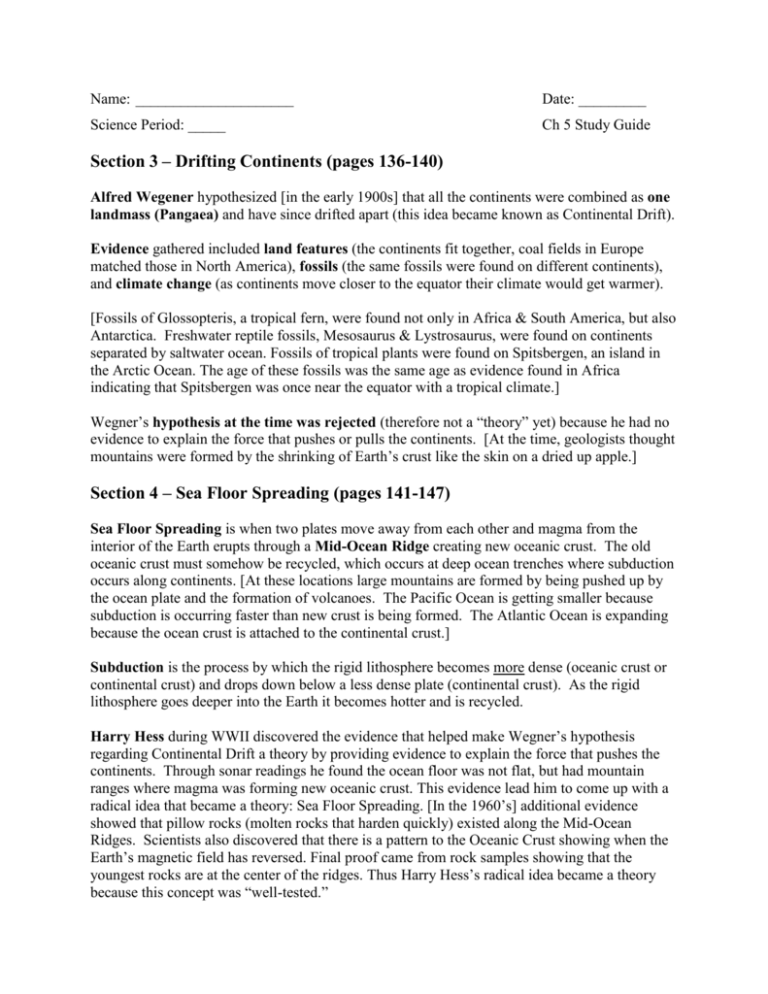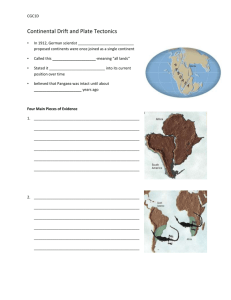rsachs8.file3b.1448118313.3.5
advertisement

Name: _____________________ Date: _________ Science Period: _____ Ch 5 Study Guide Section 3 – Drifting Continents (pages 136-140) Alfred Wegener hypothesized [in the early 1900s] that all the continents were combined as one landmass (Pangaea) and have since drifted apart (this idea became known as Continental Drift). Evidence gathered included land features (the continents fit together, coal fields in Europe matched those in North America), fossils (the same fossils were found on different continents), and climate change (as continents move closer to the equator their climate would get warmer). [Fossils of Glossopteris, a tropical fern, were found not only in Africa & South America, but also Antarctica. Freshwater reptile fossils, Mesosaurus & Lystrosaurus, were found on continents separated by saltwater ocean. Fossils of tropical plants were found on Spitsbergen, an island in the Arctic Ocean. The age of these fossils was the same age as evidence found in Africa indicating that Spitsbergen was once near the equator with a tropical climate.] Wegner’s hypothesis at the time was rejected (therefore not a “theory” yet) because he had no evidence to explain the force that pushes or pulls the continents. [At the time, geologists thought mountains were formed by the shrinking of Earth’s crust like the skin on a dried up apple.] Section 4 – Sea Floor Spreading (pages 141-147) Sea Floor Spreading is when two plates move away from each other and magma from the interior of the Earth erupts through a Mid-Ocean Ridge creating new oceanic crust. The old oceanic crust must somehow be recycled, which occurs at deep ocean trenches where subduction occurs along continents. [At these locations large mountains are formed by being pushed up by the ocean plate and the formation of volcanoes. The Pacific Ocean is getting smaller because subduction is occurring faster than new crust is being formed. The Atlantic Ocean is expanding because the ocean crust is attached to the continental crust.] Subduction is the process by which the rigid lithosphere becomes more dense (oceanic crust or continental crust) and drops down below a less dense plate (continental crust). As the rigid lithosphere goes deeper into the Earth it becomes hotter and is recycled. Harry Hess during WWII discovered the evidence that helped make Wegner’s hypothesis regarding Continental Drift a theory by providing evidence to explain the force that pushes the continents. Through sonar readings he found the ocean floor was not flat, but had mountain ranges where magma was forming new oceanic crust. This evidence lead him to come up with a radical idea that became a theory: Sea Floor Spreading. [In the 1960’s] additional evidence showed that pillow rocks (molten rocks that harden quickly) existed along the Mid-Ocean Ridges. Scientists also discovered that there is a pattern to the Oceanic Crust showing when the Earth’s magnetic field has reversed. Final proof came from rock samples showing that the youngest rocks are at the center of the ridges. Thus Harry Hess’s radical idea became a theory because this concept was “well-tested.” Section 5 – The Theory of Plate Tectonics (pages 150-154) The Theory of Plate Tectonics, developed by J. Tuzo Wilson, explains the formation, movement, & subduction of Earth’s plates. Wilson combined what geologist knew about tectonic plates, sea-floor spreading, and continental drift into one theory: The Theory of Plate Tectonics (which began as an idea or concept called Continental Drift) states that pieces of the Earth’s lithosphere (plates) are in constant motion, driven by Convection Currents (the force) in the mantle. Formation of plates (their growth) is through volcanoes and Mid-Ocean Ridges where magma is coming to the surface. Movement of plates is caused by Convection Currents within the Earth (the force that moves the plates). Subduction occurs where Oceanic Crust meets Continental Crust and the cooler and denser Oceanic Crust (& Lithosphere) goes under the Continental Crust. [Subduction also occurs where two Oceanic Crusts meet and the cooler plate drops down under the warmer plate.] Faults versus Plate Boundaries – Faults are breaks in the crust where rocks slip past each other, while Plate Boundaries are locations where these Faults occur. There are 3 kinds of plate boundaries: Divergent, Convergent, and Transform boundaries. Divergent Boundaries occur where 2 plates move apart (diverge). This occurs at Mid-Ocean ridges and rift valley’s where 2 pieces of continental crust pull apart. Convergent Boundaries occur at deep sea trenches where Oceanic Crust collides (converges) into Continental Crust & where 2 continental plates collide, forming a mountain range. Transform Boundaries occur when 2 plates slide past each other. Earthquakes occur at Transform Boundaries. Pangaea was a super continent made up of all the world’s continents [that occurred approximately 260 million years ago. Approximately 225 million years ago Pangaea began to break apart. Prior to Pangaea, other continents formed & broke up.] Note: The less important information is in [brackets]. Focus on the main concepts. Make sure you know the scientists and terms in bold.









